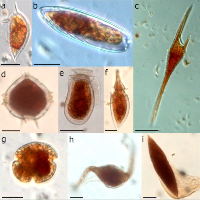An autumn biodiversity survey on heterotrophic and mixotrophic protists along a coast-to-offshore transect in the Gulf of Naples (Italy)

Accepted: 22 November 2021
HTML: 145
Supplementary Materials: 0
Supplementary Materials: 0
All claims expressed in this article are solely those of the authors and do not necessarily represent those of their affiliated organizations, or those of the publisher, the editors and the reviewers. Any product that may be evaluated in this article or claim that may be made by its manufacturer is not guaranteed or endorsed by the publisher.
Authors
Plankton communities include both unicellular and multicellular organisms. An important unicellular component is represented by those protists (i.e., unicellular eukaryotes) that consume bacteria, other protists, and even small animals. These organisms are an important link between primary producers and metazoans, and they can also be ‘mixotrophic’, coupling phagotrophic and photoautotrophic behaviours. In this note, we report on the diversity of heterotrophic protists, or protozoo-plankton (from ‘protozoan plankton’), and mixotrophic protists, or mixo-plankton , which were sampled at two sites (coastal and offshore stations), at two depths (0 and 10 m), in the Gulf of Naples during the early autumn of 2020. Our survey identified dinoflagellates and oligotrich ciliates as the most abundant groups, while tintinnids (choreotrich ciliates) were less quantitatively relevant. The taxonomic composition in samples investigated herein remarked that reported by previous studies, except for the tintinnid Ascampbeliella armilla. A coast-to-offshore differentiation in the taxonomical composition of heterotrophic and mixotrophic protists was also observed, with some species more abundant within coastal waters and other better thriving in offshore ones. These differences were associated with distinct environmental and trophic conditions.
How to Cite
PAGEPress has chosen to apply the Creative Commons Attribution NonCommercial 4.0 International License (CC BY-NC 4.0) to all manuscripts to be published.


 https://doi.org/10.4081/aiol.2021.10018
https://doi.org/10.4081/aiol.2021.10018



